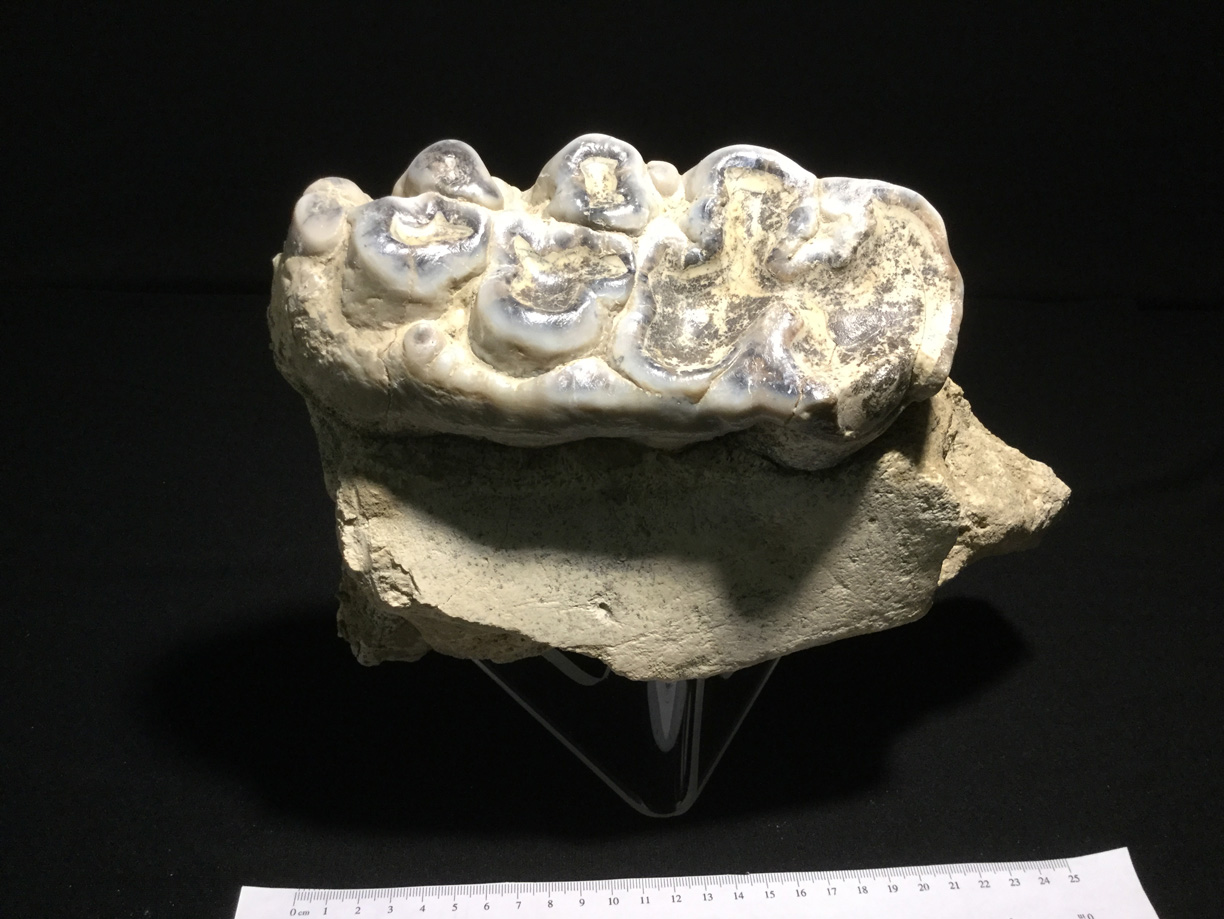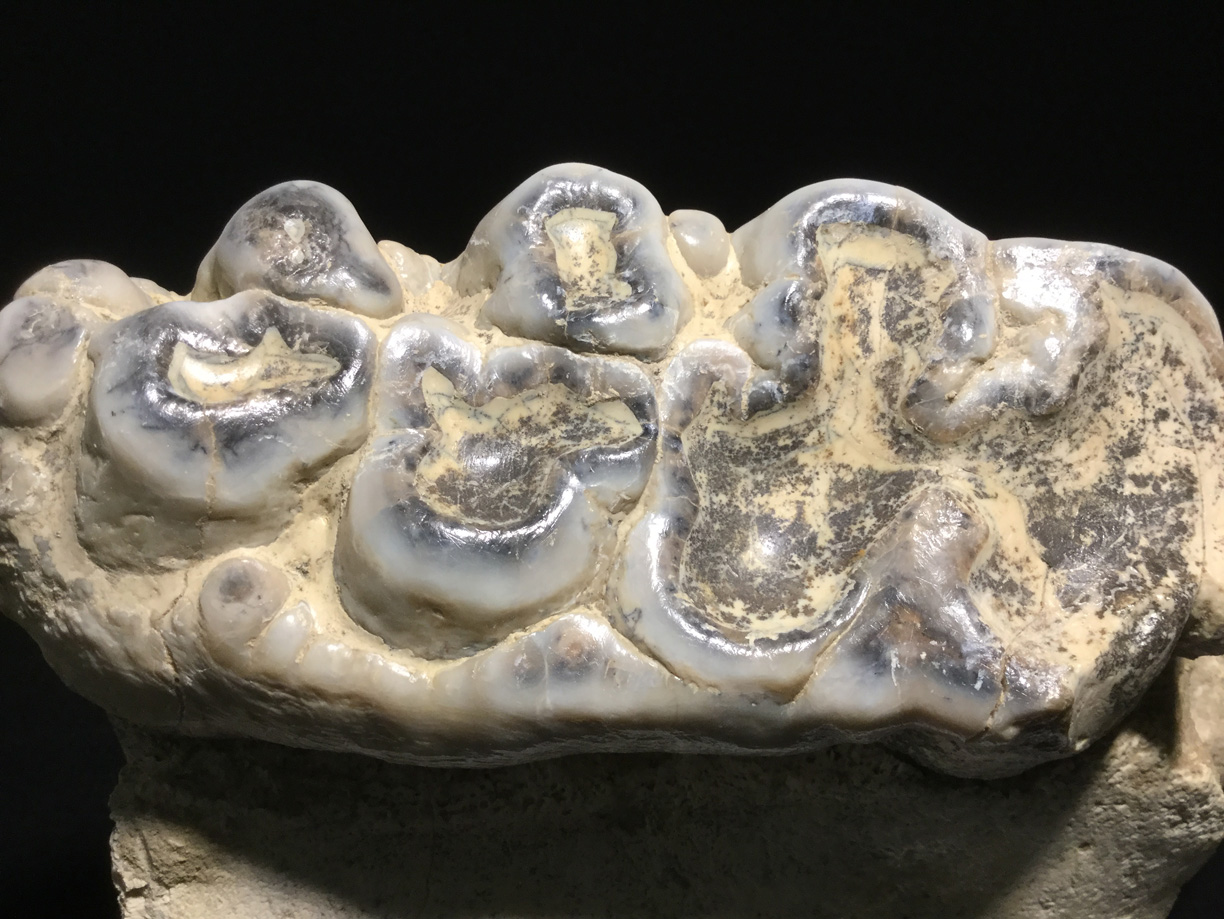

Pliocene Mastodon Tooth
Sorry, this item is no longer for sale
Gomphotherium sp.
Ogallala Formation
Pliocene (Hemphillian)
Phillips County, Kansas
Ogallala Formation
Pliocene (Hemphillian)
Phillips County, Kansas
The specimen seen here is a premier example of the Pliocene Mastodon molar. This example has a perfect molar still embedded in a section of the maxilla. The tooth has no repair or restoration and shows excellent detail. The tooth is 18 cm. long.
The type genus of the Gomphotheriidae, Gomphotherium is quite a bizarre prehistoric elephant that is quite different from the ones that we know today. Gomphotherium still had two tusks protruding down from the upper jaw, but they were recurved, which means that they gently curved towards the body rather than away like in modern elephants. The upper tusks also retained an enamel coating which is lacking in modern elephants. Two additional tusks protruded from the tip of the lower jaw to form a kind of tooth shovel which was likely used for rooting up plants.
There are no soft tissue remains of a trunk, but Gomphotherium is still thought to have possessed one since the skull is shaped to allow for the attachment of one, as well as the fact that Gomphotherium would have probably been physically unable to feed without one. The length of the trunk can vary greatly in artistic renderings but palaeontologists believe that the trunk would have been on the shorter side because of the low profile of the elongated skull. Beyond this there is currently no way of knowing exactly how long the trunk was, but logic would dictate that it would need to be long enough to be of practical use. This would mean at least long enough to reach the plants scooped up on the bottom tusks and long enough to pick up water, although Gomphotherium might have been able to cheat a little here by wading into watering holes to reduce the distance between the end of the trunk and the surface of the water. Alternatively Gomphotherium may have been able to scoop a little water with its teeth by flicking its head back before the water ran off.
Gomphotherium was one of the most successful of all the prehistoric elephants with the oldest fossils being known from North America and later ones being discovered as far as Western Europe and Africa. Usually Gomphotherium is associated with wetland ecosystems near bodies of water since the softer ground associated with these areas would allow for easier digging with the teeth. When it came to eating, Gomphotherium had fewer molars than earlier elephants, but those it had had higher ridges to make them more efficient at grinding.
The type genus of the Gomphotheriidae, Gomphotherium is quite a bizarre prehistoric elephant that is quite different from the ones that we know today. Gomphotherium still had two tusks protruding down from the upper jaw, but they were recurved, which means that they gently curved towards the body rather than away like in modern elephants. The upper tusks also retained an enamel coating which is lacking in modern elephants. Two additional tusks protruded from the tip of the lower jaw to form a kind of tooth shovel which was likely used for rooting up plants.
There are no soft tissue remains of a trunk, but Gomphotherium is still thought to have possessed one since the skull is shaped to allow for the attachment of one, as well as the fact that Gomphotherium would have probably been physically unable to feed without one. The length of the trunk can vary greatly in artistic renderings but palaeontologists believe that the trunk would have been on the shorter side because of the low profile of the elongated skull. Beyond this there is currently no way of knowing exactly how long the trunk was, but logic would dictate that it would need to be long enough to be of practical use. This would mean at least long enough to reach the plants scooped up on the bottom tusks and long enough to pick up water, although Gomphotherium might have been able to cheat a little here by wading into watering holes to reduce the distance between the end of the trunk and the surface of the water. Alternatively Gomphotherium may have been able to scoop a little water with its teeth by flicking its head back before the water ran off.
Gomphotherium was one of the most successful of all the prehistoric elephants with the oldest fossils being known from North America and later ones being discovered as far as Western Europe and Africa. Usually Gomphotherium is associated with wetland ecosystems near bodies of water since the softer ground associated with these areas would allow for easier digging with the teeth. When it came to eating, Gomphotherium had fewer molars than earlier elephants, but those it had had higher ridges to make them more efficient at grinding.










